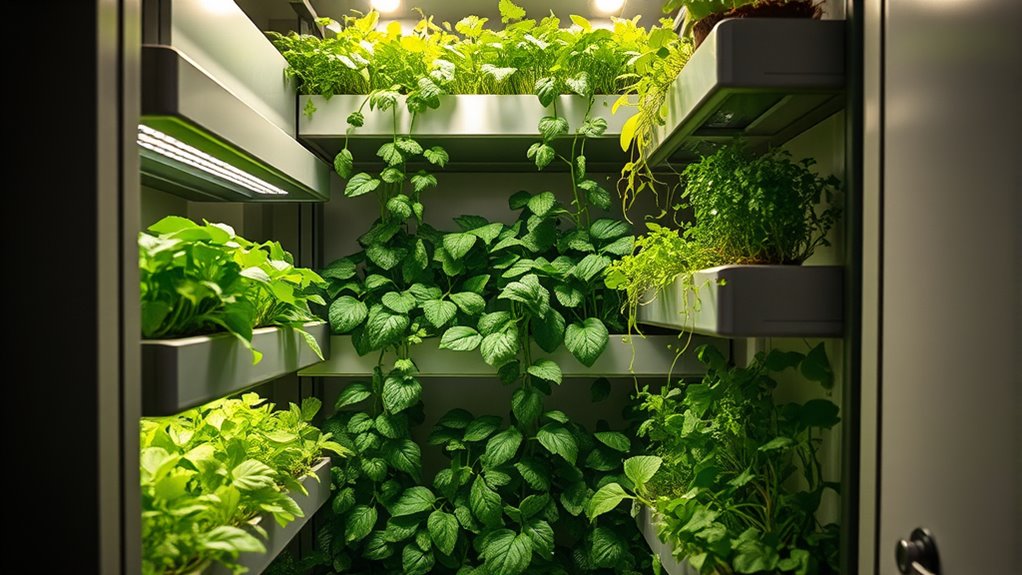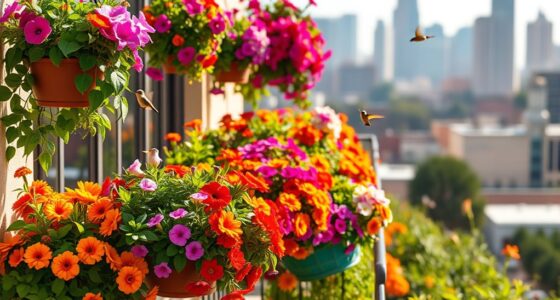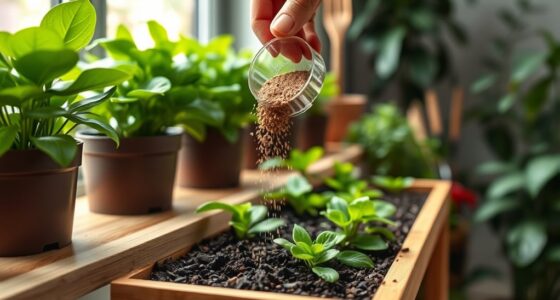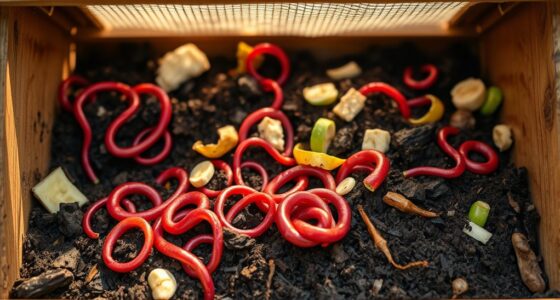Growing vertical farms in your closet is a smart way to make the most of limited space while enjoying fresh produce year-round. You can set up stackable shelves, LED grow lights, and automated watering systems to create a sustainable, eco-friendly environment. This approach helps regulate temperature and light for ideal growth, reduces water and pesticide use, and minimizes pests. If you want to discover more about creating your own closet farm, keep exploring these innovative solutions.
Key Takeaways
- Vertical farming maximizes small closet spaces by growing plants upward with stackable systems and efficient LED lighting.
- It enables year-round production of fresh vegetables and herbs directly at home, regardless of outdoor weather.
- Automated irrigation and environmental controls optimize plant health and growth while conserving water and energy.
- Suitable for urban dwellers, it promotes sustainable practices and reduces reliance on grocery stores.
- Easy-to-maintain setups with compact pots or hydroponics make indoor vertical gardens accessible and efficient.
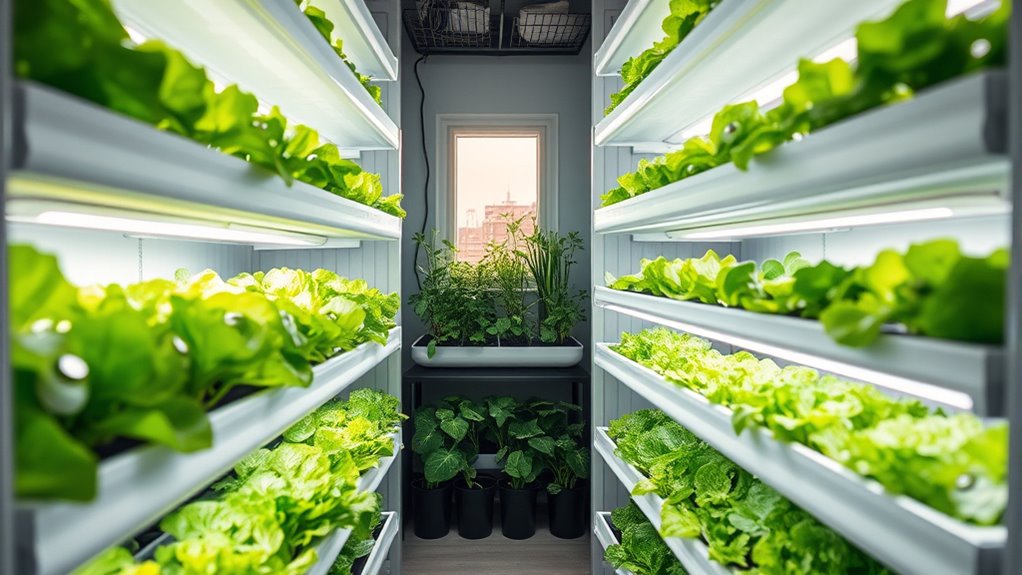
If you’re short on space but enthusiastic to grow your own vegetables, vertical farming in a closet offers an innovative solution. This method allows you to practice urban gardening efficiently, transforming limited areas into productive green spaces. By growing upward instead of outward, you maximize your available square footage and bring fresh, homegrown produce right into your living environment. It’s perfect for city dwellers who want to embrace sustainable practices without needing a backyard or large garden plot.
Vertical farming in a closet is all about smart design and resourcefulness. You can install vertical grow systems, such as stackable shelves or modular plant panels, which make the most of every inch of space. LED grow lights are essential—energy-efficient models mimic sunlight and ensure your plants get the light they need to thrive. With these lights, you can control the light cycle, encouraging healthy growth regardless of outside weather or seasons. This setup promotes sustainable practices by reducing water waste through recirculating irrigation systems and limiting the use of harmful pesticides, making your urban gardening efforts eco-friendly. Additionally, recent innovations in renewable energy technologies can be integrated to power your setup sustainably.
Growing vegetables in a closet also gives you control over the environment, creating ideal conditions for your plants. You can regulate temperature, humidity, and airflow, which leads to faster growth and better yields. This level of control minimizes the risks of pests and diseases, reducing the need for chemical interventions. As a result, you’re not only cultivating fresh food but doing so in a way that’s better for the planet. Plus, it saves you trips to the grocery store and minimizes your carbon footprint.
Starting a vertical garden in your closet is straightforward. Choose compact, fast-growing vegetables like lettuce, spinach, herbs, or radishes. Use small pots or hydroponic systems designed for limited spaces, and make sure your setup is easy to access for maintenance. Regular watering and monitoring are key—using automated systems can simplify this process, ensuring your plants get consistent moisture without overdoing it. As your plants grow, you’ll see how efficient and rewarding it is to cultivate food in such a confined space.
This approach to urban gardening not only provides fresh produce but also promotes sustainable practices by reducing resource consumption. It’s a perfect way to bring nature indoors, improve your diet, and reduce your ecological impact—all from a compact closet. Vertical farming in a closet empowers you to turn even the tiniest space into a lush, productive garden, proving that with a little ingenuity, you can grow your own vegetables anywhere.
Frequently Asked Questions
What Are the Initial Costs to Start a Closet Vertical Farm?
Starting a closet vertical farm requires a careful cost analysis to determine your initial investment. You’ll need to select equipment like LED grow lights, shelving units, and irrigation systems, which influence your overall expenses. Prices vary depending on the quality and size of your setup. Expect to spend a few hundred to over a thousand dollars initially. Planning your equipment selection wisely guarantees you stay within budget while creating an effective, efficient farm.
How Much Space Is Needed for a Successful Small-Scale Setup?
Imagine a tiny jungle thriving in your closet’s corner, where space optimization transforms limited room into lush greenery. You’ll need about 2 to 4 square feet for a successful small-scale setup, focusing on efficient use of vertical space. Lighting requirements are essential; you’ll want bright, full-spectrum LED lights to mimic sunlight. With careful planning, your closet can become a thriving indoor farm, maximizing every inch for fresh, homegrown produce.
What Types of Plants Thrive Best in Indoor Closet Farms?
You can grow many plants successfully in your indoor closet farm. Herb varieties like basil, mint, and parsley thrive well with proper lighting and watering. Fruiting plants such as cherry tomatoes and peppers also do great in small spaces if you provide adequate light and support. Focus on plants that adapt easily to limited space and indoor conditions, ensuring they receive the right nutrients, light, and humidity for healthy growth.
How Often Should I Water and Fertilize My Closet Farm?
Think of your closet farm like a small, delicate garden that needs just the right care. You should follow a consistent watering schedule, typically watering when the top inch of soil feels dry, and fertilize every two to four weeks, depending on plant type. Keep an eye on your plants to adjust as needed, ensuring they get enough nutrients and moisture without overdoing it, so they thrive in their cozy space.
Can Vertical Farming in a Closet Be Environmentally Sustainable?
Vertical farming in a closet can be environmentally sustainable if you focus on energy efficiency and water conservation. You can reduce energy use by choosing LED grow lights and optimizing light schedules. Water conservation is achieved through recirculating systems that reuse water and minimize waste. By managing these factors carefully, you help lower your carbon footprint and promote sustainable practices in your small-scale farm.
Conclusion
So, next time you complain about limited space or bland groceries, just remember: you could be growing your own salad in a closet. Who needs outdoor farms when you’ve got a tiny, eco-friendly empire right behind your door? With vertical farming, you’re practically a superhero—saving the planet one lettuce leaf at a time. So, go ahead, shrink the world down to your wardrobe. After all, why not turn your closet into the next agricultural revolution?
